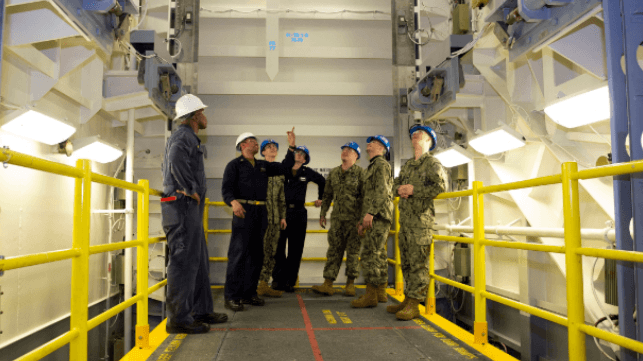Fed Up With Contractor Maintenance, U.S. Navy Pursues "Right to Repair"

After years of issues with contractor-based equipment maintenance, the U.S. Navy is joining the "right to repair" movement, Navy Secretary John Phelan told a hearing of the Senate Armed Services Committee.
The "right to repair" movement is a response to the business practice of locking up after-sales service through intellectual property, warranty and parts-access limitations. In a digital era, this affects everything from autos to farm equipment to cellphones - and, according to Phelan, even aircraft carriers and frigates. Though Navy sailors have to be ready to "fight tonight," they often aren't allowed to fix key pieces of their own equipment, and have to wait for an authorized service tech - by contract.
The problem, according to Phelan, is that the OEMs for mission-critical gear on warships still own the intellectual property for the equipment. Their contracts with the Navy forbid servicemembers from performing any repairs because of IP concerns. Instead, the equipment remains out of service until a contractor comes out to join the ship - often by traveling, and often at considerable cost.
"I went on the [USS Gerald R. Ford] carrier; they had eight ovens — this is a ship that serves 15,300 meals a day," Phelan said. "Only two were working. Six were out."
Even though the crew was capable of performing the repair, they were not allowed to do so, and had to wait for an oven contractor to come out. The same issue applies to the Ford's elevators (a persistent source of problems in the past).
"They have to come out and diagnose the problem, and then they'll fix it," he said. "It is crazy. We should be able to fix this . . . We need to really try to ensure going forward we control our IP, and we have the ability to fix things."
The Littoral Combat Ship was famously designed for a contractor-centric maintenance strategy, which became a driver of the LCS program's excessive operating cost - at one point averaging $70 million per hull per year, approaching the opex for a far larger Arleigh Burke-class destroyer.
The U.S. Army has similar problems with contractor dependency, and has decided to address this going forward by requiring right-to-repair in every contract - and forcing the issue on past contracts as well.
"We hope that anyone listening to us who hopes to pitch us a contract going forward will look back at their previous agreements they've signed with us, and if they're unwilling to give us that right to repair, I think we're going to have a hard time negotiating with them," Army Secretary Daniel Driscoll told the House Armed Services Committee last week.
